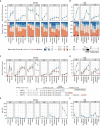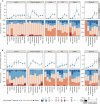Revisiting the expression of BDNF and its receptors in mammalian development
- PMID: 37426074
- PMCID: PMC10325033
- DOI: 10.3389/fnmol.2023.1182499
Revisiting the expression of BDNF and its receptors in mammalian development
Abstract
Brain-derived neurotrophic factor (BDNF) promotes the survival and functioning of neurons in the central nervous system and contributes to proper functioning of many non-neural tissues. Although the regulation and role of BDNF have been extensively studied, a rigorous analysis of the expression dynamics of BDNF and its receptors TrkB and p75NTR is lacking. Here, we have analyzed more than 3,600 samples from 18 published RNA sequencing datasets, and used over 17,000 samples from GTEx, and ~ 180 samples from BrainSpan database, to describe the expression of BDNF in the developing mammalian neural and non-neural tissues. We show evolutionarily conserved dynamics and expression patterns of BDNF mRNA and non-conserved alternative 5' exon usage. Finally, we also show increasing BDNF protein levels during murine brain development and BDNF protein expression in several non-neural tissues. In parallel, we describe the spatiotemporal expression pattern of BDNF receptors TrkB and p75NTR in both murines and humans. Collectively, our in-depth analysis of the expression of BDNF and its receptors gives insight into the regulation and signaling of BDNF in the whole organism throughout life.
Keywords: BDNF; RNA-Seq; TrkB; Western blot; development; evolution; p75NTR.
Copyright © 2023 Esvald, Tuvikene, Kiir, Avarlaid, Tamberg, Sirp, Shubina, Cabrera-Cabrera, Pihlak, Koppel, Palm and Timmusk.
Conflict of interest statement
E-EE, JT, AP, KP, and TT were employed by Protobios LLC. JT was employed by dxlabs LLC. The remaining authors declare that the research was conducted in the absence of any commercial or financial relationships that could be construed as a potential conflict of interest.
Figures











Similar articles
-
Immunoexpression of BDNF, TrkB, and p75NTR receptors in peripheral neural lesions of the head and neck.J Oral Pathol Med. 2021 May;50(5):492-501. doi: 10.1111/jop.13145. Epub 2020 Dec 30. J Oral Pathol Med. 2021. PMID: 33222311
-
Effects of NaHS and hydroxylamine on the expressions of brain-derived neurotrophic factor and its receptors in rats after cardiac arrest and cardiopulmonary resuscitation.Scand J Trauma Resusc Emerg Med. 2018 Dec 22;26(1):109. doi: 10.1186/s13049-018-0577-z. Scand J Trauma Resusc Emerg Med. 2018. PMID: 30577733 Free PMC article.
-
Down-regulation of brain-derived neurotrophic factor and its signaling components in the brain tissues of scrapie experimental animals.Int J Biochem Cell Biol. 2016 Oct;79:318-326. doi: 10.1016/j.biocel.2016.08.033. Epub 2016 Aug 30. Int J Biochem Cell Biol. 2016. PMID: 27590859
-
The BDNF/TrkB Neurotrophin System in the Sensory Organs of Zebrafish.Int J Mol Sci. 2022 Feb 27;23(5):2621. doi: 10.3390/ijms23052621. Int J Mol Sci. 2022. PMID: 35269763 Free PMC article. Review.
-
BDNF/TRKB/P75NTR polymorphisms and their consequences on antidepressant efficacy in depressed patients.Pharmacogenomics. 2015;16(9):997-1013. doi: 10.2217/pgs.15.56. Epub 2015 Jun 30. Pharmacogenomics. 2015. PMID: 26122862 Review.
Cited by
-
Neurotrophins and Their Receptors: BDNF's Role in GABAergic Neurodevelopment and Disease.Int J Mol Sci. 2024 Jul 30;25(15):8312. doi: 10.3390/ijms25158312. Int J Mol Sci. 2024. PMID: 39125882 Free PMC article. Review.
-
An 840 kb distant upstream enhancer is a crucial regulator of catecholamine-dependent expression of the Bdnf gene in astrocytes.Glia. 2024 Jan;72(1):90-110. doi: 10.1002/glia.24463. Epub 2023 Aug 25. Glia. 2024. PMID: 37632136 Free PMC article.
-
Exercise-conditioned plasma ameliorates postoperative cognitive dysfunction by activating hippocampal cholinergic circuit and enhancing BDNF/TrkB signaling.Cell Commun Signal. 2024 Nov 18;22(1):551. doi: 10.1186/s12964-024-01938-7. Cell Commun Signal. 2024. PMID: 39558340 Free PMC article.
-
The intriguing role of platelets as custodians of brain-derived neurotrophic factor.Res Pract Thromb Haemost. 2024 Apr 3;8(3):102398. doi: 10.1016/j.rpth.2024.102398. eCollection 2024 Mar. Res Pract Thromb Haemost. 2024. PMID: 38706782 Free PMC article.
-
Role of Brain Derived Neurotrophic Factor and Related Therapeutic Strategies in Central Post-Stroke Pain.Neurochem Res. 2024 Sep;49(9):2303-2318. doi: 10.1007/s11064-024-04175-z. Epub 2024 Jun 10. Neurochem Res. 2024. PMID: 38856889 Review.
References
LinkOut - more resources
Full Text Sources
Molecular Biology Databases

